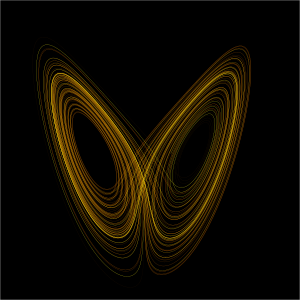Dynamical systems theory facts for kids

Dynamical systems theory is a special part of applied mathematics. It helps us understand things that change over time. Think of it like studying how things move, grow, or behave in a changing world.
This field uses special math tools, like differential equations and difference equations. These equations are like recipes that describe how a system changes from one moment to the next.
Contents
What is Dynamical Systems Theory?
Dynamical systems theory looks at how things behave over a long time. It studies systems that are always in motion or changing. This could be anything from a swinging pendulum to the weather or even how animal populations grow.
Continuous vs. Discrete Systems
There are two main types of dynamical systems:
- Continuous systems: These systems change smoothly, all the time. Imagine a clock with hands that move without stopping. We use differential equations to study these.
- Discrete systems: These systems change in steps or jumps. Think of a digital clock that changes numbers only every second. We use difference equations for these.
Why Do We Study Dynamical Systems?
Scientists and mathematicians study these systems to predict what will happen in the future. They want to understand patterns and behaviors that might seem complicated at first.
Real-World Examples of Changing Systems
Dynamical systems theory helps us understand many things around us. Here are a few examples:
- Planets moving: How planets orbit the sun is a dynamical system. Scientists use this theory to predict their paths.
- Weather patterns: The weather is a very complex dynamical system. Small changes can lead to big differences later, which is why forecasting can be tricky.
- Electronic circuits: How electricity flows and changes in a circuit can be described using these ideas.
- Population growth: How populations of animals or people grow or shrink over time is another example.
- Biology and medicine: It helps understand how diseases spread or how the human heart beats.
By studying these systems, we can learn to predict, control, or even design things better. It's all about understanding the rules of change!

